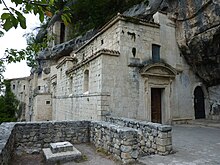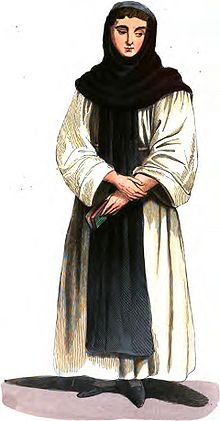Cölestiner

The Celestine or Celestine made an order within the Roman Catholic Church , the Ordo Sancti Benedicti Coelestinensis , religious symbol : OSBCoel , also: Congregation Coelestinensis .
history
The order was created in 1244 as a subdivision of the Benedictine order , from which the founder of the order , Peter von Morrone, who later became Pope Celestine V , comes from. He decided to lead a life as a hermit in Abruzzo on Mount Morrone near Sulmona . Some like-minded people followed him and formed a spiritual community there, which was recognized by Pope Urban IV in 1263 and incorporated into the Benedictines . Due to the great popularity of the later Pope, the order initially received greater popularity; Monasteries emerged mainly in the Kingdom of Sicily . From 1300 onwards Philip the Fair promoted the Cölestines in the Kingdom of France in his dispute with Boniface VIII . From there branches of the order in the Netherlands and in Bohemia, z. B. on the mountain Oybin in 1366, founded.
In the 17th century the female order of the Cölestinerinnen was created .
The last Celestine monasteries (including the Chiesa dell'Ascensione a Chiaia ) were abolished between 1806 and 1810 in the Kingdom of Naples and Sicily under French rule in the course of secularization .
Personalities
An important inquisitor from the ranks of the Cölestiner was Petrus Zwicker († 1403).
See also
literature
- Joachim Göbbels: Cölestiner. IC (Damianists) . In: Lexicon of the Middle Ages (LexMA). Volume 3, Artemis & Winkler, Munich / Zurich 1986, ISBN 3-7608-8903-4 , Sp. 9-11.
- Karl Borchardt: The Cölestiner. A community of monks from the late Middle Ages. Matthiesen Verlag, Husum 2006 (historical studies 488), ISBN 978-3-7868-1488-7
Web links
- Meister Eckhart and his time: Cölestiner (copied from the Lexicon of the Middle Ages)
- Publications on the Celestines in the Opac of the Regesta Imperii

